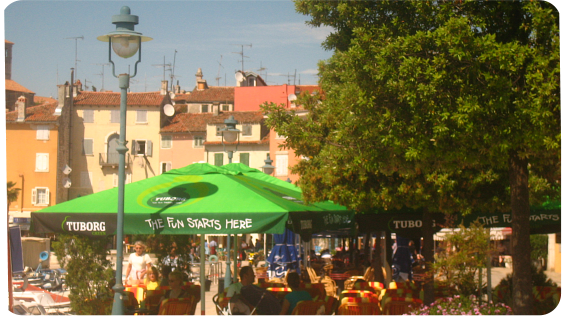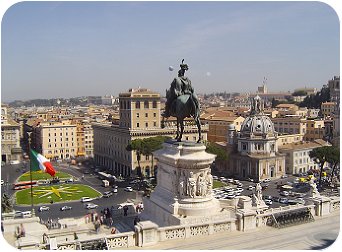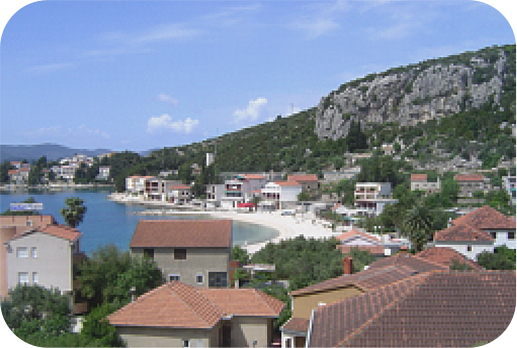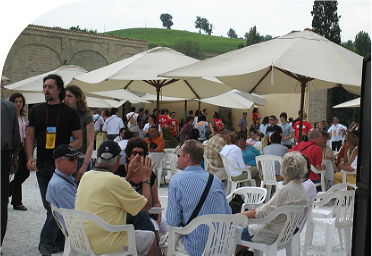Tales of Big Julie and Foraging the Forum There is something about pondering the Forum…
Riding the Dalmation Coast to Rovinj
Download a PDF Version of this article
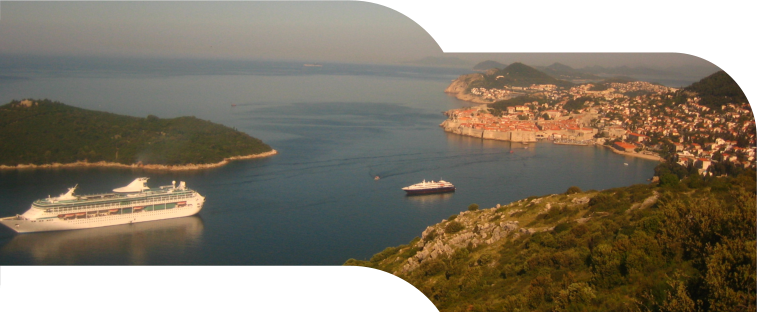
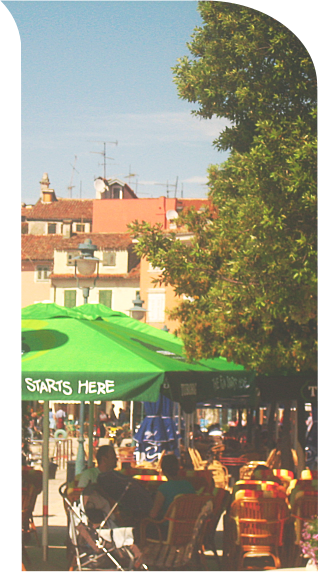 Trend setters beware the best way to travel in Croatia is with the very efficient bus system that allows plenty of stops and with judicious seat placement a perched eyrie to purvey the ultra scenic coastline.
Trend setters beware the best way to travel in Croatia is with the very efficient bus system that allows plenty of stops and with judicious seat placement a perched eyrie to purvey the ultra scenic coastline.
Leaving Dubrovnik over the coat hanger bridge the road heads along the coast until 60 kilometres from Dubrovnik the Peljesac Peninsular starts at the bay leading to Ston and Mali Ston the home of the Ottoman salt works. Here are the world famous oysters and mussels in great rafts out into the placid waters surrounded on the hillside by a necklace of turrets and fort walls. These walls stretch like a grey worm over the hills and go for 5 kms with 41 towers and 2 forts dating from 1000AD but enlarged in the 13th and 14th Centuries. Perhaps they were protecting the seafood and the best Peljesac vinos even in those times?
The journey continues in a never-ending vista of water and holiday areas all in a sombre loneliness of the May off-season. A notable difference is the delta like paddy fields of Opuzen the tangerine capital. The major interest stopover is entering Neum in Bosnia-Herzegovina where a 10 kilometre sector of territory bisects Croatia. It is a cursory stop at the border that barely drags the ubiquitous cigarette out of the guard’s mouth to do a visual check… In comparison to the prior journey the area looks like a badly developed East German holiday resort of times past. Perhaps the prior finery of the coast spoils visual appraisal but there is no intrinsic beauty in these concrete bunker like units.
The bus has a dual purpose stopping in Neum as any Croatian leaps into the wayside stop wrestling packets of fags and bottles of liquor from the duty-free shelves as hungry passengers swarm the char grills.Beautiful coastal villages and beaches flash through the Kodak psyche and
eventually a mutual common ground of unbridled beauty settles as a benchmark. The Makarsker Riviera seems to be the domestic playground and
drifts into the Gradac triangle as more upmarket multinational beach resorts follow.
White beaches fringed with trees and buildings right to the waters edge hug the roadside on the longest beach in the Dalmatian Adriatic. The road
continues alongside the rocky mountainous terrain as it follows the coastline, forts on the horizon and pockets of village houses that seem merely to act as rock barriers. The trip falls into the somewhat ordinary environs of the Split outer industrial area and surrounding burbs toward the waterfront again. A bus change at the ever efficient Split terminal and the uninspiring ride for 25kms to the UNESCO listed town of Trogir with its touches of Dubrovnik, Hvar and Syracuse wrapped into one parcel. There has been continual habitation for 2300 years from the Greeks, Romans to the destruction in the 11th Century by Saracens to the rebuild by the Venetians.
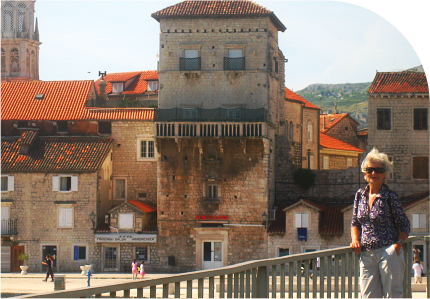 The drop off at the bridge to Trogir town allows a quick dumping of chattels at one of the many cafes leaving companions as a deposit whilst the Croatian sport of Sobe Solitaire commences. Any wandering traveller is aware that there is no need to stick firmly to an itinerary as the signs for Sobe/Zimmer/Rooms are plastered about and one can inspect, haggle or leave according to whim. Forty minutes of scurrying about the ancient town and Ciovo Island quickly enables a decision at E50 a double for a quirky room inside the Pizza Vanjaka Café. Vanjaka has a kitchen one floor up from the square below and the 2 rooms upstairs were accessed via the restaurant accompanied by a homely smell coming from the ovens drifting warmly into the living space. The kitchens service outside tables in two small areas in the squares from 9am to 10pm underneath the ancient gables of the cathedral. The church circa 11th century had mass every day as according to our host Vanja there are 3 priests in Trogir “nothing for them to do all day but make Masses”
The drop off at the bridge to Trogir town allows a quick dumping of chattels at one of the many cafes leaving companions as a deposit whilst the Croatian sport of Sobe Solitaire commences. Any wandering traveller is aware that there is no need to stick firmly to an itinerary as the signs for Sobe/Zimmer/Rooms are plastered about and one can inspect, haggle or leave according to whim. Forty minutes of scurrying about the ancient town and Ciovo Island quickly enables a decision at E50 a double for a quirky room inside the Pizza Vanjaka Café. Vanjaka has a kitchen one floor up from the square below and the 2 rooms upstairs were accessed via the restaurant accompanied by a homely smell coming from the ovens drifting warmly into the living space. The kitchens service outside tables in two small areas in the squares from 9am to 10pm underneath the ancient gables of the cathedral. The church circa 11th century had mass every day as according to our host Vanja there are 3 priests in Trogir “nothing for them to do all day but make Masses”
The old town is an Island of Renaissance and baroque buildings adjoining tiny winding alleys with the majority of locals living on the Island of Ciovo in apartments and tidy semi detached buildings more suburban than most places in Croatia. Wandering the area
reveals the residents all grow vines over carports and structures surrounded by micro plots of healthy vegetables. On the skyline are
the vestiges of ship building gantries from a past industry but now detuned to suit local construction.
Sunday the bells tolled as locals gathered after mass in the square outside the 13th Century Church of St Lawrence competing with a claxon like brass band with members made up of 4 generations. Unfortunately this noise must have awoken a passing cruise boat of touring chimpanzees as they poured in chittering and cooing blindly gathering to block out all the elderly people seated around. This blasting cacophony of evergreens was followed by a time warp parade of eight marching girls dressed in short uniforms of the sixties. This seemingly incongruous scene was highlighted by the baton twirling of the girls of Trogir throwing as to a different beat as twinkling smiles passed between them.
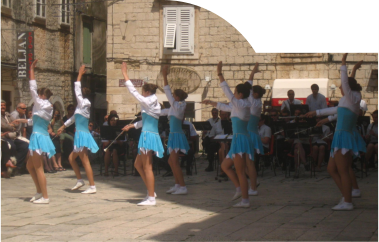 Sunday afternoon belongs to the yachting fraternity and the esplanade becomes a show-piece for chandlery, berthing, drinking and the social promenading commenced. The local Lotharios began to drift up and down in a style reminiscent of the Italian passigiata seemingly no more engrossed in life other than strutting. There was a uniform of quasi militaria, long sideburns and 90% wearing jeans some seemingly painted on the adherents. Café cruising and good food is the other local Derby but noticeable amongst the dwellers were the empty glasses as most sit on one drink.
Sunday afternoon belongs to the yachting fraternity and the esplanade becomes a show-piece for chandlery, berthing, drinking and the social promenading commenced. The local Lotharios began to drift up and down in a style reminiscent of the Italian passigiata seemingly no more engrossed in life other than strutting. There was a uniform of quasi militaria, long sideburns and 90% wearing jeans some seemingly painted on the adherents. Café cruising and good food is the other local Derby but noticeable amongst the dwellers were the empty glasses as most sit on one drink.
It is a cheap session to sit with a cold Pivo Ozujsko looking out at a modern scene blending seamlessly with the ancient backdrop in what must be one of the more friendly villages of the world. The central market over the main bridge had a World Series cured meat section blending in a great marriage with the local cheeses and soon traveller’s packs were purchased for the on going journey.
Trogir is the best-preserved Romanesque-Gothic complex in all of central Europe as its medieval core is surrounded by walls internalizing a preserved castle and tower. One can recognise why places like this need protection under world heritage statutes which was further amplified by chatting with our host. Her simple reasoning was that if the United Nations had not stepped in the locals would have sold the farm and prostituted sites due to unemployment and low local wages.
The trials and travesties of leaving Trogir are exacerbated by the vehicles delivering the produce for the Monday market and the Rejika bus was almost hard to find let alone board for the 7 hour journey. The cost from Dubrovnik was $30, to Rijeka $53, and the transit to Rovinj in Istria a further $11 so travel and comfort was not expensive.
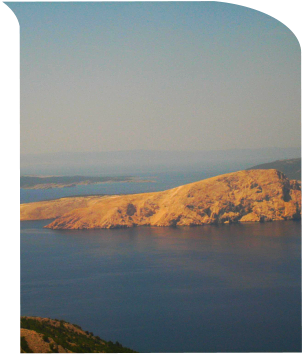 The trip to Rovinj is a long day’s travel and every part holds interest as the majority of the route follows the coast then diverts onto Pag Island to travel its length until popping out onto a ferry back to the mainland. The Dalmatian Coast ends at Zadar and the scenery changes radically once the area is reached. The trip is another coastline of perfect towns like Mandre Simouni, Primos which look like the must stop holiday destinations redolent of the lower coastline of the Makarska 60 kms before Split. If there ever was a chance to slowly drive this coastline how would one ever make a decision where to stop and play. The change of scenery after leaving this area takes on a more fort like guise with random buildings popping up in nondescript places. The Islands are barren rock so blastingly lunar, sundrenched white, the landscape blitzing the horizon in contrast to the azure sea. Made me think Sir Richard Burton may well have misnamed the Mountains of The Moon as no vegetation other than green splashes in ravines appear testing the viability of any grazing animals. Pag is famous for its cheese leading one to believe perhaps the paucity of feed concentrates the flavours. The Island has the longest coastline in Croatia and its notoriety as a site for the murder of 10,000 Jews in WWII is its historical infamy. The bus in typical Croatian fashion seems to stop at any gathering of five houses and let’s loose the odd passenger at the confluence of any lonely road connection. The ride on the ferry is a good diversion providing both a chance to get sea air, a refreshment break and a walk around the decks.
The trip to Rovinj is a long day’s travel and every part holds interest as the majority of the route follows the coast then diverts onto Pag Island to travel its length until popping out onto a ferry back to the mainland. The Dalmatian Coast ends at Zadar and the scenery changes radically once the area is reached. The trip is another coastline of perfect towns like Mandre Simouni, Primos which look like the must stop holiday destinations redolent of the lower coastline of the Makarska 60 kms before Split. If there ever was a chance to slowly drive this coastline how would one ever make a decision where to stop and play. The change of scenery after leaving this area takes on a more fort like guise with random buildings popping up in nondescript places. The Islands are barren rock so blastingly lunar, sundrenched white, the landscape blitzing the horizon in contrast to the azure sea. Made me think Sir Richard Burton may well have misnamed the Mountains of The Moon as no vegetation other than green splashes in ravines appear testing the viability of any grazing animals. Pag is famous for its cheese leading one to believe perhaps the paucity of feed concentrates the flavours. The Island has the longest coastline in Croatia and its notoriety as a site for the murder of 10,000 Jews in WWII is its historical infamy. The bus in typical Croatian fashion seems to stop at any gathering of five houses and let’s loose the odd passenger at the confluence of any lonely road connection. The ride on the ferry is a good diversion providing both a chance to get sea air, a refreshment break and a walk around the decks.
Entry into Rijeka is via a large ship building and refurbishment port with the bus travelling into the city down tree lined avenues to drop passengers at the station for the Rovinj connection. The route to Rovinj exits through the Villas and opulence of Opatija a throw back to an Austrian Imperial enclave presenting a late 19th Century image. The road follows the 12 km promenade along the coast where the Austrian emperor Franz Joseph built palaces and his court resided in the mansions.
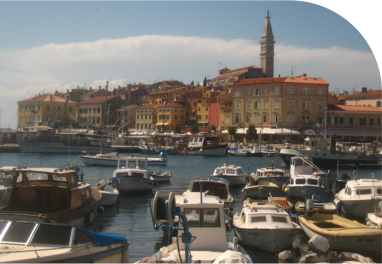 Leaving the coast up a steep curve through chestnuts and conifers and into Lapin which was the home of Croatia’s largest coal mine and in fascist days incorporated as a separate miner’s state for a few months. The town is reminiscent of a Russian apartment town with Gothic long haired youths idly watching the bus passage through the outskirts. The route to Rovinj via Pula is two half hours and entry to the station belies the proposition that this is a waterfront town.
Leaving the coast up a steep curve through chestnuts and conifers and into Lapin which was the home of Croatia’s largest coal mine and in fascist days incorporated as a separate miner’s state for a few months. The town is reminiscent of a Russian apartment town with Gothic long haired youths idly watching the bus passage through the outskirts. The route to Rovinj via Pula is two half hours and entry to the station belies the proposition that this is a waterfront town.
Rovinj Originally an Island of Roman origin has both Italian and Croatian names, mutual historical backgrounds plus officially it is a bilingual town with 65% of the population Croat. The Venetians had ruled Istria for many centuries with all Italian control relinquished at the end of WWII as it reverted to greater Yugoslavia. For the first time in Croatia accommodation proved harder to find with a paucity of sobe signs leading to enquiries at an information bureau. Rapid phoning draws out Giula an Italian widow who scuttles around to herd her new clientele down to her E43 per night, 1 bedroom internal suite at Aldo Negri, on a waterfront board-walk.
A morning walk around a picture perfect marina reveals the extent of the Venetian influence as a mosaic of faded pinks, yellows and all shades thereof worked them selves into a tortured torte of intersecting buildings. This town is a perfect three day stopover if the issue is not a rest and recreation holiday as shopping; eating drinking and slothing were the prerequisites for brain fodder. The influence food wise seems Austrian rather than Croatian and noticeable was a large Germanic burble in the café conversations. Precision and good service in Café La Mare Robert on the waterfront provided a choice meal of Cevpcici, risotto, grilled pork, chicken and squid served with the paprika onion relish that takes the place of the Balkans ajvar. To have good fare at the right price with organic house red wine reminds one of the pleasures of yesteryear before the anxiety of Nouveau cuisine overload foisted its iniquitous mini portions onto diner’s tabletops.
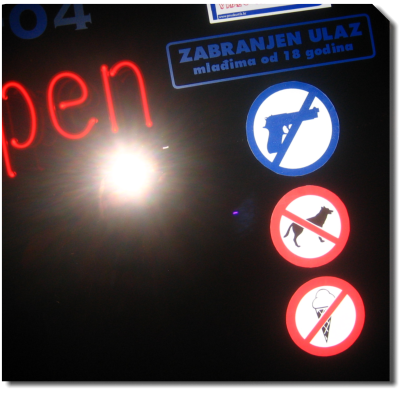 The harbour is chockfull of small craft but is noticeably short changed in mega boats of the rich and famous perhaps they were across the water in Venice two hours away. A walk onto the original Island to the perched Church of St Francisco , which is by far the tallest structure on the hill, is via narrow lanes of strategic greenery, perky apartments and trendy shops. Stopping for crisp white wines, wood fired breads and pizza is an easy task as no pressure is exerted to move or order further.
The harbour is chockfull of small craft but is noticeably short changed in mega boats of the rich and famous perhaps they were across the water in Venice two hours away. A walk onto the original Island to the perched Church of St Francisco , which is by far the tallest structure on the hill, is via narrow lanes of strategic greenery, perky apartments and trendy shops. Stopping for crisp white wines, wood fired breads and pizza is an easy task as no pressure is exerted to move or order further.
The afternoon draws down and a definitive move is afoot as the population lingers in the extended daylight to drink and eat at the cafés lining the perimeter. The dusk closes in the surrounding islands as lights blink on the Cathedral and larger buildings, perhaps, paying homage to the rising thump from the Monvi entertainment area. This area houses the nightclub sector… not perhaps in full stream in May but no doubt getting ready to waken once the summer hit.
The alternative cacophony is the large cat population that haunts these alleys reminiscent of that boyhood song‘Cats on the roof tops ,cats on the tiles some with siffo and some with piles ,some with their rectums wreathed in smiles as they revel in the joys of copulation’ Yes even the car roof tops were being used as performance platforms oblivious to the passing population. Rovinj is a large Hvar with rubbish; but the nearby Adriatic Islands no doubt draw the boating fraternity through and it is a base to explore the Roman Amphitheatre in Pula 40 minutes away. Pert villages are inland and day trips to the sedentary life are the alternative to the booming tourism trade that does dilute the experience at the wrong time of the year. Whistle-stop tours do abound in singular experiences but there are so many places to see in the Croatian coast where or how can it all fit in.
Perhaps one can contemplate the inexorable persuasion of the signs outside the Rovinj Harbour Casino and wonder what dastardly harm after the banning of guns and dogs the prospect of an armed ice cream could do?
